#We love characters with an incredible arc that reframes them so intensely that you the reader will never be the same after.
Explore tagged Tumblr posts
Text
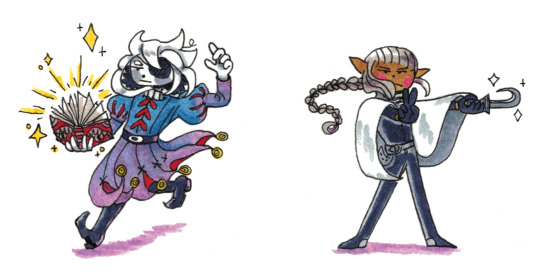
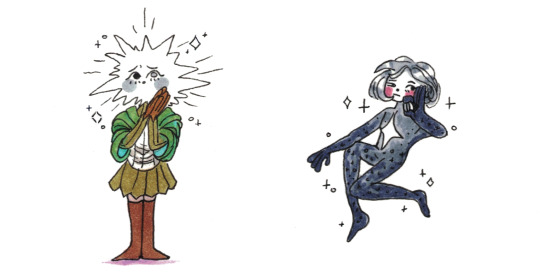
ISAT & Dungeon Meshi swap!
#in stars and time#ISAT#Siffrin#Loop#Dungeon Meshi#Thistle#Mithrun#This is incredibly self indulgent art but I've been doing commissions for other people - I can have this treat.#Two series that have me in a death grip right now and boy did the realization of the parallels between these characters hit hard.#Siffrin and Thistle are the “Forgot what it was all for” duo. The “I'm scared to let it go (it must be let go)” duo.#Loop and Mithrun are [REDACTED] [GO CHECK OUT THESE SERIES SPOILER FREE]#God I have so much to say about the Loop and Mithrun parallels. I won't here because I refuse to spoil people on ISAT.#What I *will* say is that both these characters had a similar curve in my interest in them.#Which is “I was ambivalent until the near end - where they then shot up to become some of my favourite characters ever.”#We love characters with an incredible arc that reframes them so intensely that you the reader will never be the same after.#Anyways! (rotates both these crossovers in my head at a rapid orbit and gazes at them fondly).#This is my sandbox and I get to eat the sand!!!#I've got some MDZS/ISAT swap content coming soon as well. My sand eating knows no limits apparently.
596 notes
·
View notes
Text
The Re-Making of Grace of Monaco: the Unfinished Cut
In the summer of 2013, I was invited by the now defunct U.S. distributors of a feature film I had written called GRACE OF MONACO to participate in the editorial process for a U.S. theatrical cut. As a writer, it was a rare and unusual position to be in. I had never edited a movie before. Never meaningfully set foot in an edit room. Only seen working cuts. Though I was very reluctant about stepping into the arena, I knew this work was going to happen anyway. As a producer on the movie, it was part of my required duties on a project that had been subject to much behind-the-scenes drama (check press for details). I decided to assist how I could in the attempts to restore some of the narrative focus, tone and characterizations that were in the screenplay but not in the finished movie. So much of cinema is about interpretation of the written word — lighting, dressing, design, direction, delivery and performance — that it was never a process of recapturing what was on the page (even if some of the scenes and dialogue were exact). But about re-imagination and careful detective work. About trial and error. A look here. A smile there. A line here. Page by page. Scene by scene. Reshaping story arcs and character movements. Work that often, I have since learned through post-production on my subsequent movies working with some incredibly talented and giving filmmakers, is ideally meant to be part of an intense collaboration between director, writer and producer. 10 years on, it’s become clear with the passing of time that this experience was a black swan that I will never live through again in my career. But yet it seems with the passing years, and the changing headwinds in the business, this cut will be lost for good. I'm not aware of any other copies existing anywhere else. It would be a shame, because those few instructive and fascinating months proved educational enough for me personally to share as an academic and historic record (should any film historians find use for this).
As such, what follows is FOR EDUCATIONAL PURPOSES ONLY.
A few words about what you're going to see for those of you who have never been in the process. This is not a finished movie. This is a working print of the movie many weeks prior to a picture lock; the moment the picture edit is done and you move on to other post production work — VFX, color correction, Automated Dialog Replacement (ADR), looping, scoring, sound mixing, and so on. As such, there is no grading, the film is raw stock dailies, incomplete VFX, temp score, and you'll be doing as much reading as you would watching for all the ADR work. It was meant for many weeks more of input from the director, from the producers, from test audiences. It’s a work half-done. It's a unique viewing experience, but I hope an educational one. Also, no reshoots! The goal was to recut using existing material using the original script for guidance.
So, how is this cut different?
From Melodrama to Drama. A considerable toning down of the heightened style, to get to a more sober portrayal, and more evocative of the era. This included a more subdued and direct form of editing, and a new approach to the score.
Narrative cohesion to center on Grace’s journey and her conflicted relationship with Rainier. At its heart this was a story about a husband and wife who got married first, then figured the rest out later. This is all about POV and the choices Grace has to make to double down on or reject what may have been the biggest mistake in her life. An unhappy woman who married her glamorous Prince, but now trapped in a grotesque place — except she has kids, and doesn’t know how to get out. It’s a tragedy. A story of acceptance. There is no nobility and quite a lot of sadness to the love affair. There were some baroque moments in the script that weren’t shot (for example, Grace taught her kids not to bite by biting them), that would have helped with getting into Grace's psyche. Nevertheless, the intent was to restore some of the essence of this to the movie. To get to the core of Grace’s self-actualization.
Create context for Monaco. Monaco in 1962 was trying to reframe itself as a tax haven to come out from under French colonial rule. They had rich people, they had grotesque people, but at its core, it was mostly a small provincial principality trying to make the most with very little. Monaco in 1962 was different to the Monaco of today, which Rainier subsequently remade into his vision of unbridled wealth and excess. When he echoes Thomas Jefferson in this cut, during a speech that was in the script but not in the other versions, there is an attempt to understand the underlying darkness of this. That though we may not (and should not) agree with him, we can see where his underlying motivations are what Grace has got herself into.
Restructuring of the plot in some cases for more clarity and suspense. To more effectively balance the marriage story with the thriller aspects of the coup plot.
Delivery and additional dialogue. ADR requirements were extensive due to the shift from melodrama to drama. These are an attempt to mute the power of the delivery. So you’ll be reading a lot, as you will in context-setting scenes such as the opening “wall of sound” news-reels.
A final word on the much discussed original screenplay, with almost a decade of hindsight. It was written without much expectation, and a good deal of naivety. The work of a young writer starting out in Hollywood, who found a small pocket of history he found fascinating. Did I think it would end up under such intense scrutiny? Never in my wildest dreams. But fools go where angels fear to tread. Reading it back today, it feels like a great early draft, but not yet a movie, and with a lot of story and character left to be mined. For this I’ll need a whole other essay, but suffice to say it needed more time to develop. I regularly use it today as an example for young writers to show the pitfalls of moving to the production phase before the screenplay has been properly cooked. I will also make available the original treatment and first draft screenplay soon, again FOR EDUCATIONAL PURPOSES ONLY. The treatment I remain very fond of because of the cleanness of its execution.
Finally … is this cut better or worse? Does any of this matter? I don’t know. That’s not the object of this exercise. I leave that for you the viewer to decide. It’s just different. It's impossible to remake a movie after its inception and execution. But the U.S. theatrical cut, as it was to be in an alternate timeline, exists in an orphaned semi-completed state. I moved on a long time ago but Quarantine 2020 opened up some time that allowed me to crack open old files, reflect and revisit those memories, good and bad. Not least of all learning how radically different versions of a movie are possible in post-production with the same material and with creative re-writing. Editing and screenwriting it seems do go hand in hand.
Amel
Quarantine, April 2020
vimeo
4 notes
·
View notes
Text
Episode 60: Keeping It Together
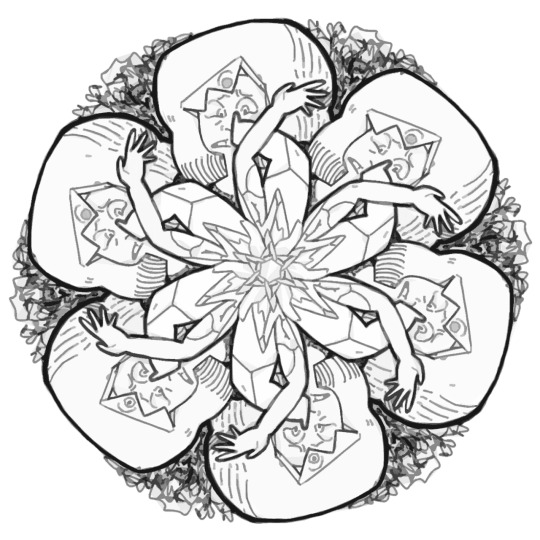
“It’s not our fault!”
Does Steven Universe have a more ominous setting than the Prime Kindergarten? Rose’s Room comes close (and I maintain that Rose’s Room is the scariest episode of the series), but episodes featuring it always pay off the unsettling setting with an actual scare. Whereas the muted colors and cacophonous clangs of Kindergarten maintain a constant thrumming dread, promising something horrible and imminent, and lets that tone linger uninterrupted. Amethyst’s fight with Pearl in On the Run is intense, and the Crystal Gems confronting Peridot in Marble Madness ramps up the suspense, but we haven’t seen any true horror from Kindergarten until now.
And yeah, holy shit.
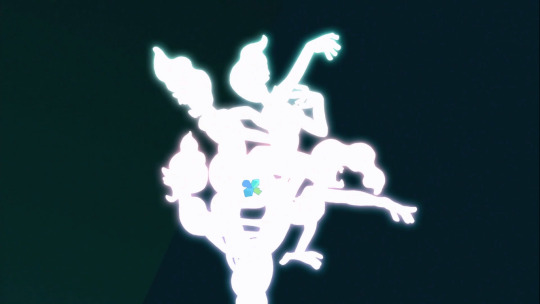
As I mentioned in Reformed and Sworn to the Sword, Keeping It Together establishes Garnet’s next big arc. But hers is much different from her fellow Gems’, both in structure (it’s the shortest by far and resolves with its Peridot Episode instead of its Steven Episode) and in tone. Garnet is the emotionally healthiest Gem on the planet right now, so she needs a bigger push than Amethyst or Pearl if she’s going to lose her cool. This isn’t to belittle the other two Gems, but there’s a reason the prompts for their episodes are day-to-day issues (for them) like renewing their physical forms or training a student, while Garnet needs dramatic scenarios like the Cluster Gems or a friend’s betrayal to reach the same level of crisis.
In short, external motivation is everything to Garnet’s arc because she lacks the internal baggage of her peers. There’s nothing unhealthy about being queer a fusion, so her problems stem from societal oppression that targets her for being who she is. We’ve seen her face fusionphobia with grace against Jasper, and we’ll see that bookended with Peridot when the season ends, but an attack on her identity as abhorrent as the Cluster Gems is certainly grounds for an extreme reaction.
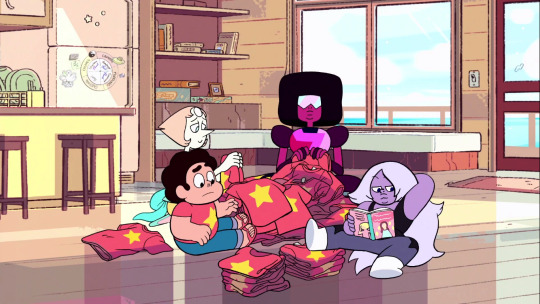
We’ll get there, but first I have to point out how well-structured this whole episode is. The opening revels in switcheroos, first with Garnet’s serious conversation turning out to be part of a chore session, then with two red herrings in quick succession: the hint that we might see Ruby and Sapphire, and an extended callback to On the Run suggesting a focus on Amethyst.
From there, the episode looks like it’s going to be about Steven settling into his own new status quo as a more respected member of the Crystal Gems. And in a way, it is! We spend a lot of time with him, and he summons his shield without any fanfare when the going gets tough. But it makes sense to focus on him more here than in Reformed and Sworn to the Sword, because Garnet’s status as a fusion is still novel to him and has changed their relationship in a way that warrants examination. And in an episode about Garnet encountering forces that don’t understand fusion to a horrific degree, it’s a soothing contrast to see Steven’s own misunderstanding come in the form of genuine curiosity.
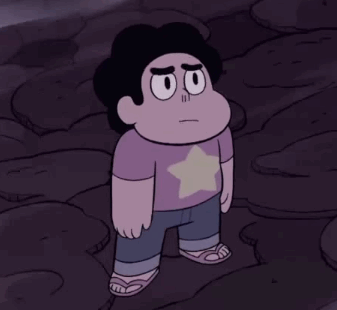
Steven is also where we get a lot the goofiness that often accompanies the show’s horror episodes, but don’t let the clip of his spectacular shrug fool you, the comedy crown here goes to Peridot. This is the episode that tips the scales on Peridot as a villain: she began as a coldhearted alien, and her bureaucratic fussiness emerged in Warp Tour and Jailbreak, but now she fully transitions from a menacing opponent to a panicky thorn in the Crystal Gems’ side. All it takes is one look at Steven to make her lose her worker bee cool, and the action scene that follows plays her increasingly absurd bag of tricks for laughs as she outmaneuvers our heroes.
Peridot’s newfound jitters make sense on a character level, as she lost her power and is stuck on a world she knows is doomed. But the silliness that ensues also works wonders for Keeping It Together’s structure: by making her such a loud source of comedy, her exit marks a concrete tonal shift from goofy to grave. And by making her someone to be pursued, we get rid of Amethyst and Pearl in the process. And by revving up to a breakneck pace to follow her zany action, we reach the third act around the episode’s halfway mark to let it sink in that much deeper. Thanks, Peridot!
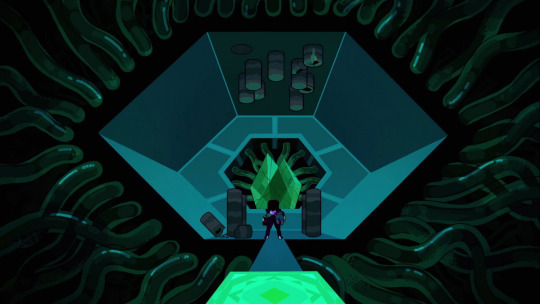
After focusing on Garnet in the episode’s onset, we’re right back to hanging out with her again. She’s even more confident than usual here, accepting Steven’s effusive praise with a simple “thank you” and acknowledging out loud that she’s great, to show us how big of a deal her panic attack is. We’ve seen her handle monster after monster without breaking a sweat, and she even defeats Jasper with a smile hours after getting destabilized. But the Cluster Gems hit her where it hurts, and seeing Garnet get rattled like this is far scarier than the monsters themselves.
Not to take away from Aivi and Surasshu’s awful Cluster Gem theme (great, but awful), but the true sound heroes of this scene are whoever designed the ungodly noises these things make. Considering nobody is credited as “Monster Scream Maker” I’ll go ahead and shout out the whole sound design team for this one: Timothy J. Borquez, Susy Campos, Tony Orozco, Daisuke Sawa, Robert Serda, and Tom Syslo. I have no idea how their jobs work, but I’m so glad they’re so great at what they do.
And then of course there the visuals, and dear lord are they upsetting. The drizzle of mismatched body parts starts small, with a hand and foot that happen to match Ruby and Sapphire’s colors taking the Gem Shard concept we’ve seen in Frybo and Secret Team to a whole new level of creepy. But the limbs get bigger and bigger until the excruciating reveal of five screaming Gem ghosts transforming into a monstrous “arm” reinforces Garnet’s pained explanation of what these Cluster Gems actually are: the remains of her long-dead friends forced together.
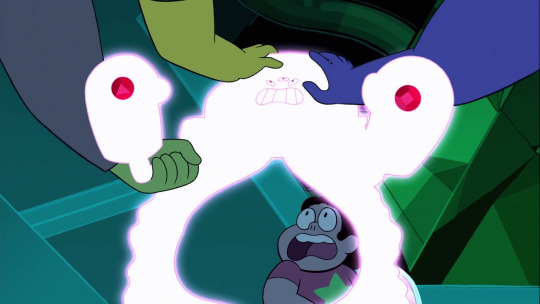
But even then, even as Garnet is literally falling apart, she manages to push through the horror and save the day with Steven’s help, leading to Estelle’s showstopping argument with herself. Where A.J. Michalka’s frequent use of separate voices for Steven and Connie shows Stevonnie’s youthful uncertainty, Estelle’s normally steady performance makes her frantic and distinct portrayals of Ruby and Sapphire a shocking swerve. It both subverts and fulfills our expectation of seeing Garnet’s two halves after Stephen brought them up during laundry, and brings home the idea that splitting up isn’t a fun party trick no matter how much Stephen (and fans) want to see more of them.
The little details here are amazing. I love that it’s Ruby’s eye that tears up during the fight, but by the aftermath she’s moved to rage while Sapphire is still reeling; one lives moment to moment, and the other thinks in the long term. I love that gaps in the conversation are filled by them clearly sharing the same thoughts, namely that Rose might have known about these experiments and kept them secret; the notion that this is even possible foreshadows how dark Rose’s secrecy is going to get in the coming episodes. And even though it’s tragic, I love that the header quote can first be read as Garnet’s guilt over being part of the rebellion that caused her friends to suffer, but can be reread after The Answer as guilt over prompting the Diamonds’ interest in fusion. It’s not her fault, but it certainly would feel like it was.
But therein lies the difference between Garnet and Amethyst/Pearl: guilt this intense would shut the latter two down, but by the end of the episode Garnet has kept it together. She’s still upset, and she should be, but she’s not letting herself drown in her sadness and anger.
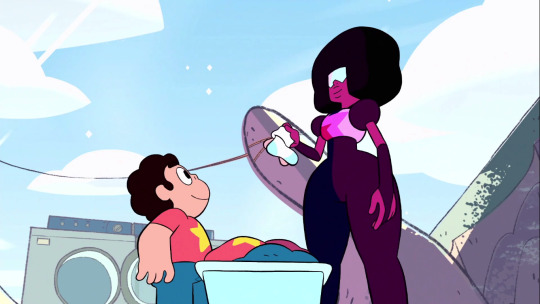
The Week of Sardonyx is about to test Garnet again, and Pearl’s betrayal can hit even harder now that we’ve explicitly been told about the importance of consent in fusion. And as I hinted at earlier, fusion’s multipurpose metaphor extends to a specifically queer reading that’s vital to Garnet’s arc. I honestly wouldn’t mind being hammered over the head with the message that homophobia is bad, because yeah, homophobia is bad and kids should know that and children’s media doesn’t bring it up very often. But like everything to do with fusion, the Steven Universe team handles the allegory factor with incredible finesse. There’s no one-to-one analogy between fusion and queerness beyond Ruby and Sapphire both presenting as female; indeed, the mistreatment of queer people in the real world rarely includes forcing them into long-term relationships with each other a la the Cluster Gems, and Homeworld society only finds fusion acceptable in same-Gem relationships, so it’s actually heterophobic if we want to get stupid and pedantic.
This show doesn’t need an episode about conversion therapy or corrective rape to display the horror of an outside force perverting what you are and oppressing who you are, and Garnet’s journey through Season 2 shows that Steven Universe isn’t content with presenting two women in a relationship and patting itself on the back for being progressive. The fact that the show addresses homophobia with sensitivity but without pulling punches is something entirely new, but the fact that it’s doing so while enhancing a character and advancing the main plot is even more outstanding.
Future Vision!
The headline here may be kicking off Garnet’s arc, but it also revs up the Cluster Arc: these shard fusions are bad, but who could’ve guessed they were apocalyptically bad?
Peridot’s surprising resilience to large objects and gravity is as true in the Beta Kindergarten as it is in the Prime, if Kindergarten Kid is anything to go by.
The question of whether Rose could’ve known details about Diamond tactics reframes Sapphire’s rage in Now We’re Only Falling Apart.
If every pork chop were perfect, we wouldn’t have inconsistencies…
As great as Steven is here, would he really be that surprised that he’s coming along? I get that they’re showing that the status quo of getting some respect is still new to him, but yeah, after saving everyone in Jailbreak I think he’s pretty official. Enh, just a gripe, it’s implemented well enough.
We’re the one, we’re the ONE! TWO! THREE! FOUR!
I think just above On the Run sounds right for Keeping It Together. It’s a terrific Garnet episode with a welcome side of Peridot, and manages to set the stage for a new arc while culminating Kindergarten’s foreboding tone with a bang.
Top Fifteen
Steven and the Stevens
Mirror Gem
Lion 3: Straight to Video
Alone Together
The Return
Jailbreak
Sworn to the Sword
Rose’s Scabbard
Coach Steven
Giant Woman
Winter Forecast
Keeping It Together
On the Run
Warp Tour
Maximum Capacity
Love ‘em
Laser Light Cannon
Bubble Buddies
Tiger Millionaire
Lion 2: The Movie
Rose’s Room
An Indirect Kiss
Ocean Gem
Space Race
Garnet’s Universe
The Test
Future Vision
Marble Madness
Political Power
Full Disclosure
Joy Ride
Like ‘em
Gem Glow
Frybo
Arcade Mania
So Many Birthdays
Lars and the Cool Kids
Onion Trade
Steven the Sword Fighter
Beach Party
Monster Buddies
Keep Beach City Weird
Watermelon Steven
The Message
Open Book
Story for Steven
Shirt Club
Love Letters
Reformed
Rising Tides, Crashing Tides
Enh
Cheeseburger Backpack
Together Breakfast
Cat Fingers
Serious Steven
Steven’s Lion
Joking Victim
Secret Team
Say Uncle
No Thanks!
4. Horror Club 3. Fusion Cuisine 2. House Guest 1. Island Adventure
(No official title card for this one, likely due to Keeping It Together being part of a Steven Bomb, but luckily this piece from Vondell Swain will do.)
33 notes
·
View notes
Text
Attack on Titan Season 2 Episode Analysis - Episode 6 (Episode 31)
Since we only just resolved this season’s first arc, I had assumed that this episode would consist solely of characters’ reflections on past events and set up for future ones. I am happy to report that this episode is a little more eventful to say the least.
First though, we do need to recover after last week’s emotionally draining conclusion and recap exactly where we are at. On that note, I am so, so happy to see that Ymir is alive (though comatose). I was genuinely saddened at the thought of her being dead, even if that death made logical, emotional and motivational sense. Still though, it definitely makes sense that Ymir has survived - I mean, if Eren could survive being almost digested, surely Ymir can survive losing a chunk of her digestive tract? Titan shifters are clearly made of much sterner stuff.
With Ymir out of commission so to speak, Christa (or should I call her Historia?) has to explain the situation to Hanji and defend Ymir’s actions. As Historia argues, even though Ymir hid vital information, in the end she used her powers to save her comrades, proving her loyalty. Furthermore, while Ymir concealed many vital secrets, she was motivated by the simple (read: selfish) aim of protecting herself, rather than any nefarious conspiracy. Hanji, too, completely understands that Ymir has the potential to be a great asset to humanity, as long as they can ensure that she is first and foremost an ally.
I feel like we’re seeing the psychological impact of Christa reasserting her identity last episode as she successfully convinces Hanji; Christa is really coming into her own as Historia (I’m still getting used to writing that name XD)! Historia’s gentle appearance and manner has always belied her fierce determination and formidable strength, so I love seeing this strong side.
There’s still something else hanging in the air that needs to be addressed though. As Hanji brings up Christa’s true identity, Historia Reiss, a pained, pensive expression crosses Historia’s face. For Historia, this name brings a painful weight, along with countless bad memories. So when Hanji comfortingly pats her shoulder and says “nice to meet you”, this oppressive weight almost immediately lifts and the mood changes palpably. In this one line, Hanji reframes Historia’s reclamation of her name, not as a resurrection of pain and strife, but rather, as a new beginning. Yes, it’s only a very short scene, but there’s always time for some character development!
But these brief scenes are basically all moot compared to the real meat of this episode; and that is Reiner. I thought I had a handle on who Reiner was as a person. Sure, there was a lot I didn’t know about him, but I still thought that after all this time I understood who he was in a general sense. Boy, was I wrong! The moral of the story is don’t get cocky, I guess.
We first see Reiner struggling to climb onto the top of the wall with his injured arm. Noticing this, Eren immediately goes to help him, holding out his hand which Reiner accepts without hesitation. By introducing Reiner here, this brief scene reinforces our basic understanding of Reiner and Eren’s relationship; they are comrades who unconditionally trust each other. The camera lingers on the shot of their gripped hands, a symbol of camaraderie, trust and unity.
This is all very basic stuff, but it is crucial setup for Reiner’s eventual betrayal. From the beginning, the show is hinting that something is up through multiple shots of Reiner (and Bertholdt) reflected in puddles. It’s a concise, elegant way too remind us that there is more to Reiner than meets the eye and that we will soon be seeing another side to him. This quick scene at the beginning of the episode quickly establishes a foundational understanding of Reiner’s place in the characters’ minds, which the show can now start to complicate, deconstruct, and, in the end, destroy.
Reflecting on the night’s events, Reiner begins to freak out about his very recent near-death experience. In my episode 4 analysis, I wrote about how Reiner exemplified the show’s critique of the ideal of heroic sacrifice. To recap, Reiner’s actions in episode 4, though superficially heroic, are ultimately presented as foolhardy, impulsive and unnecessary. Interestingly, Reiner realises this as well, reeling at his actions and blind heroism. In this moment, Reiner confronts his own mortality and he’s honestly not handling it well.
Reiner, as we have heretofore understood him, has embodied three essential ideas: bravery, loyalty and stability; basically the perfect soldier. In this one scene, the show begins to break this down by showing us that behind his brave actions lies very real fear and weakness.
Throughout this scene Bertholdt looks on with an intensely stressed expression on his face. As a side note, I have to say Bertholdt is perhaps one of the most enigmatic characters in the show. Until this episode, I would have simply dismissed him as unremarkable and frankly, forgettable. I mean, the only thing I could have said about him was that he is tall and strong – it’s almost hilarious how these two seemingly mundane facts actually function as clues to his real identity.
It’s hard to express how weird, awkward and generally unsettling this scene is, along with the episode as a whole. What should be a comforting moment of safety and contemplation for our characters never materialises, with everyone palpably unsettled, stressed and clearly still on guard.
This feeling only intensifies when Hannes confirms what we’ve known for a while now: there is no hole in the wall. In the face of such an inexplicable mystery, the only option is to retreat to Trost and regroup. As they start to walk off though, Reiner asks Eren to stay back for a moment and we finally get to the big reveal of this episode.
Now, AOT is a show built on shocking twists and turns and it’s really, really good at them. The problem with this however is that after a while the audience inevitably becomes accustomed to these reveals and they no longer shock like they used to; AOT’s unpredictability becomes, in a sense, predictable. Additionally, viewers get better at figuring out the twist well in advance. I think a lot of people had already figured out that Reiner is the Armoured Titan (it’s the hair isn’t it?). So how do you make a reveal like this shocking without the audience rolling their eyes and smugly thinking that they’re way ahead of the show? - Context and framing!
You see, AOT knows that after 30 episodes the audience doesn’t just expect a twist; they also expect a certain amount of melodrama and set up before the twist is revealed. Historically, information that is this important and this world shattering doesn’t just get told to us or to the characters. They have to fight tooth and nail, risking their lives for it.
So to have this twist calmly revealed by Reiner so unceremoniously with no setup or conflict whatsoever, it’s not only a surprise; it’s just wrong. Paradoxically, it’s how completely and utterly anti-climactic this reveals is that makes it so, so shocking and so effective. This is absolutely world-changing information, and both Reiner and the show itself are treating it like a run-of-the-mill conversation - like it doesn’t matter at all! In this way, even if the specifics of information aren’t necessarily shocking, the way in which it is presented to the audience definitely is! It’s using our own understanding of dramatic and storytelling conventions against us and it’s pretty genius.
This is all wonderfully and effectively supported by cinematic language. There’s no dramatic music, no intense, emotional close-ups; just a cold, disinterested distance. Every shot and edit all works together to express both the mundanity and the abruptness of this revelation, so I’m going to spend the next section unpacking it!
We start with a shot focused on Mikasa in the foreground as she walks out of frame, leaving Eren, Reiner and Bertholdt in the background. Now, this isn’t a good shot by any stretch of the imagination; in fact, it’s dreadfully ordinary and incompetent. This shot isn’t trying to be visually compelling though. Instead, it’s actively trying to misdirect and distract us.
By focusing initially on Mikasa, our attention is immediately drawn away from the three boys. Furthermore, the blocking of the characters is incredibly awkward and uncommonly inexpressive, with Eren and Reiner facing away from the camera. Every bit of this framing tells us one thing, loudly and proudly; nothing noteworthy is happening. The shot is literally telling us to not pay attention.
Then Reiner calmly says that he and Bertholdt destroyed the wall 5 years ago and that their ultimate aim is to destroy humanity. We’re not even shown his face as he says this! This is one of the craziest, most revolutionary reveals of the show, and it is presented to us, cinematically and contextually, as if Reiner were talking about the weather.
No time to register this information though, as the show immediately cuts to Hanji pondering how the titans could have appeared within the wall. We’re already taking a second longer to process what Reiner just revealed after we pre-emptively dismissed it; now, this medium shot of Hanji’s intense but irrelevant contemplation actively tries to distract us again.
Then, as Reiner admits that he is the Armoured titan and Bertholdt is the Colossal titan, we cut to a wide shot of the scouts walking away from this scene, highlighting their obliviousness to the traitors in their midst. At this point, we’ve caught up with the implications of what Reiner is saying, but with the multiple points of focus, giving us a lot to process visually. This, along with the lowered volume of Reiner’s dialogue further limits our ability to absorb the true implications of this information remains limited.
It’s all so masterfully done. I am consistently impressed by how well-made and thought out this show is, and how, against all odds, it manages to stay fresh after all this time. Bravo.
Now, as this scene unfolds, I assumed that everyone’s uneasy demeanour was just a general reaction to the frankly confusing situation they’ve found themselves in. However, as we flashback 12 hours earlier, we are shown that the whole scout corps already suspected something amiss with Reiner and Bertholdt. Thus, another layer of complexity is added to this scene and the charged atmosphere is reconfigured as a feeling of anticipation and hyperawareness.
For the 104th cadets, it’s important to understand just how much they trust Reiner. Reiner was like a brother to them, a rock of the team if you will. Their loyalty to him is so deep that they almost can’t believe that he could have been conspiring against them this whole time. Thus, this part of the episode works to further destroy one previously foundational aspect of our understanding of Reiner: loyalty.
As the facts pile up against Reiner, Eren continues to defend him though, becoming increasingly distressed at the mere suggestion that he could be a traitor. After all he’s been through with Reiner and Bertholdt, as friends and soldiers, it’s almost impossible for him to conceive of them as enemies. Tragically, Eren’s only error here is that he’s too loyal and too trusting. In any other situation, these would be admirable traits. But when everyone is a potential threat and the wrong decision could mean the eradication of humanity, Eren’s naivety means he is ill-equipped to deal with the situation at hand.
You see, Eren is inherently idealistic (or to be cruel, naïve) and truly believes in humanity and his comrades. This unwavering belief in the value of humanity is essential to his triumphs, as it gives him the strength to overcome impossible odds and prevail over the greatest despair. However, in order to retain this idealistic view of a cruel world, Eren has been forced to adopt an incredibly black and white understanding of morality. In Eren’s mind, you’re either intrinsically good and trustworthy, or you’re irredeemably evil and monstrous.
Crucially though, Eren naively assumes that reality reflects his view of the world and is unable to conceive of anything that falls outside of this stark dichotomy of good and evil. Dangerously, this blinds him to the reality of the world and makes him more vulnerable to manipulation. Additionally, because his worldview and ideals are continuously and cruelly challenged, with people proving themselves more complicated than this, Eren is inevitably traumatised precisely because of his strict adherence to such a rigid understanding of humanity.
So in the face Reiner and Bertholdt’s betrayal, let’s just say Eren isn’t going to deal with it well. Still, with all this in mind, he actually does a pretty good job defusing the situation and placating Reiner, trying to react as anyone would to such a preposterous proposal by playing it off as a delusion or even a joke. Bertholdt seems all too eager to use this as an out – he too is flying by the seat of his pants – and enthusiastically agrees.
However, Eren goes too far when he recklessly decides to question Reiner’s thought process. The only reason Reiner would have revealed his secret to Eren is because he seriously thought there was a chance Eren would agree to come quietly. Frankly, this is an irrational, illogical idea and any person in their right mind would know that this wouldn’t work, but not Reiner. It’s kind of innocent or even idealistic, that Reiner could possibly think that Eren would agree to his proposal, but also worryingly delusional. So when Eren points this fact out, Reiner is genuinely shocked, dismayed, and maybe even hurt.
Gradually, this episode has broken down every conception we’ve had of Reiner as a person. We believed Reiner was physically strong, so we were shown his emotional weakness. We believed Reiner was loyal, so we were shown his betrayal. And now, though we believed Reiner was stable, now we’re shown his instability. He’s not cool and collected at all, he’s irrational and volatile. Visually, this episode has been tense and unsettling throughout, with stormy skies and violently waving flags, symbolising the constantly shifting situation at hand and Reiner’s unstable psyche. So when the flag pole suddenly snaps, we know that Reiner has made a decision. There is no going back now.
Suddenly, Reiner declares that he’s been here too long for his own good and he becomes deeply ashamed his naivety. Though he is committed to his cause, some part of him, I think, does genuinely care about everyone he’s fought with. In his irrational state, offering Eren an opportunity to come quietly and prevent the eradication of humanity seemed like a valid way to reconcile this his greater plan with his new ties. However, realising the impossibility of any compromise, he now feels his only choice is to commit to his duty as a warrior and see their plan through to the end, no matter the consequences.
Throughout the show, Reiner has described himself as both a soldier and warrior, and the difference between these terms is crucial to the choice Reiner makes. The term ‘soldier’ recalls ideas of strength, bravery, loyalty and stability; essentially, our past conception of Reiner. Crucially, unlike a warrior, to be a soldier one must be part of an army. Thus, the term ‘soldier’ also brings up associations of conformity, disciple and camaraderie. In contrast to this, the concept of a warrior exists independent of a larger group and thus symbolises individuality, agency and power. A soldier fights in an army for a community but a warrior fights for himself. Thus, in his decision to be a warrior, Reiner forsakes his community, deciding to fight as an individual for his own enigmatic desires.
This pace has been slowly quickening, building up tension, and now it all comes to a head as Reiner and Bertholdt put their plan into motion, transforming into their titan forms. Until this moment, I don’t think Eren truly believed or, at the very least, understood the implications of what Reiner revealed to him. He’s actually sobbing at what he is forced to face in Reiner. Treasured memories flash through his mind, of training with Reiner and Bertholdt, confiding in them and trusting them. Eren truly loved both of them.
But now, as Eren watches the world turn to chaos around him, Reiner’s status as titan and traitor finally sinks in and eradicates his conception of him as friend and comrade. But if they’re not his friends, then what are they? They are monsters, they are irredeemable traitors and they need to be destroyed.
#attack on titan#shingeki no kyojin#shingeki no kyoujin#aot#snk#reiner braun#bertholdt hoover#eren jaeger#Christa#christa lenz#historia#historia reiss#hanji#hanji zoe#reiner#eren#bertholdt#anime#aot episode 31#snk episode 31#snk ep 31#aot ep 31#reviews#anime analysis#anime criticism#attack on titan season 2#snk season 2
10 notes
·
View notes